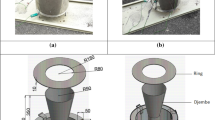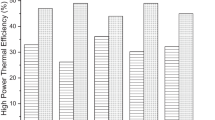Abstract
The widespread adoption and sustained use of modern cookstoves has the potential to reduce harmful effects to climate, health, and the well-being of approximately one-third of the world’s population that currently rely on biomass fuel for cooking and heating. In an effort to understand and develop cleaner burning and more efficient cookstoves, 15 stove design and fuel/loading combinations were evaluated in the laboratory using the International Workshop Agreement’s five-tiered (0–4) rating system for fuel use and emissions. The designs evaluated include rocket-type combustion chamber models including reduced firepower, sunken pots, and chimneys (three stoves); gasifier-type combustion chambers using prepared fuels in the form of wood pellets (four stoves); forced draft stoves with a small electric fan (five stoves); and a single insulated charcoal stove with preheated secondary air. It was found that a charcoal burning stove was the only stove to meet all the Tier 4 levels of performance. Achieving over 40% thermal efficiency at high power was made possible by reducing firepower and gaps around the pot, although batch-fed stoves generally do not “turn down” for optimal low power performance. While all stoves met Tier 4 for carbon monoxide, only stoves equipped with electrical fans reduced respirable particulate matter to Tier 4 levels. Finally, stoves with chimneys and integrated pots were fuel efficient and virtually eliminated indoor emissions. It is hoped that these design techniques will be useful in further development and evolution of high-performance cookstove designs.









Similar content being viewed by others
References
Agenbroad J, DeFoort M, Kirkpatrick A, Kreutzer C. (2011) A simplified model for understanding natural convection driven biomass cooking stoves—Part 2: With cook piece operation and the dimensionless form. Energy for Sustainable Development 15(2):169–75
Bailis R, Ogle D, MacCarty N, Still D, Smith KR, Edwards R (2007) The water boiling test, version 3.0. Technical report, University of California, Berkeley. http://www.pciaonline.org/node/1048. Accessed May 15, 2014
Baldwin, S. (1985) Testing the Efficiency of Woodburning Cookstoves. Volunteers in Technical Assistance, Arlington
Baldwin S (1987) Biomass stoves: engineering design, development, and dissemination. PhD thesis, Center For Energy and Environmental Studies, Princeton University, Princeton, NJ
Bond, T.C. et al. (2013) Bounding the role of black carbon in the climate system: A scientific assessment. Journal of Geophysical Research-Atmospheres. 118(11):5380-5552. DOI: 10.1002/jgrd.50171
Bryden, M., Still, D., Scott, P., Hoffa, G., Ogle, D., Bailis, R., Goyer, K., & United States. Environmental Protection Agency. Office of Air and Radiation. (2005) Design principles for wood burning cook stoves. Washington, DC, USA
Clean Cooking Catalog (2014). http://catalog.cleancookstoves.org/#/stoves. Accessed May 26, 2014
International Energy Agency (IEA), (2010) “Energy Poverty: How to make modern energy access universal?” World Energy Outlook, Paris
ISO (2012) Guidelines for Evaluating Cookstove Performance. IWA 11, Switzerland: International Organization for Standardization
Jetter J, Zhao Y, Smith KR, Khan B, Yelverton T, DeCarlo P, Hays MD. (2012) Pollutant emissions and energy efficiency under controlled conditions for household biomass cookstoves and implications for metrics useful in setting international test standards. Environmental Science & Technology. 46(19):10827-10834
Johnson M (2014) Proposed indoor emissions tiers for cookstoves. http://www.pciaonline.org/files/10-Performance-Measures-web.pdf. Accessed May 17, 2014
Johnson NG (2005) Risk analysis and safety evaluation of household stoves in developing nations. MS thesis, Iowa State University, Ames, Iowa
Kshirsagar, M.P., Kalamkar, V.R. (2014) A comprehensive review on biomass cookstoves and a systematic approach for modern cookstove design. Renewable and Sustainable Energy Reviews 30: 580–603
Lim, S. S., et al. (2012) “A Comparative Risk Assessment of Burden of Disease and Injury Attributable to 67 Risk Factors and Risk Factor Clusters in 21 regions, 1990-2010: A Systematic Analysis for the Global Burden of Disease Study 2010,” Lancet, 380, pp. 2224–2260
MacCarty, N. A., Still, D. K., Ogle, D. M., (2010) “Fuel Use and Emissions Performance of Fifty Cooking Stoves in the Laboratory and Related Benchmarks of Performance,” Energy Sustainable Dev., 14, 161–171
MacCarty N, Bryden KM (2013) A heat transfer model for the conceptual design of a biomass cookstove for developing countries. In Proceedings of the ASME 2013 International Design Engineering Technical Conference & Computer and Information in Engineering Conference IDETC/CIE 2013, Portland, Oregon, August 4–7, 2013
Mitchell J (2013) Review of ISO international workshop agreement cookstove guidance. In 2013 Engineers in Technical Humanitarian Opportunities of Service Conference, Seattle, WA. http://www.vrac.iastate.edu/ethos/proceedings2013.html. Accessed May 17, 2014
Modi, V., McDade S., Lallement, D., and Saghir J. 2005. Energy and the Millennium Development Goals. New York: Energy Sector Management Assistance Programme, United Nations Development Programme, UN Millennium Project, and World Bank
Pennise, D.M., et al. (2001) Emissions of greenhouse gases and other airborne pollutants from charcoal making in Kenya and Brazil. Journal of Geophysical Research 106(D20):24143-24155
Reed TB, Larson R (1996) A wood-gas stove for developing countries. In Developments in Thermochemical Biomass Conversion Conference, Banff, Canada, May 20–24
Standards & Testing (2014). http://www.cleancookstoves.org/our-work/standards-and-testing/learn-about-testing-protocols/. Accessed May 17, 2014
WHO (World Health Organization) (2006) WHO air quality guidelines for particulate matter, ozone, nitrogen dioxide and sulfur dioxide. Global update 2005: summary of risk assessment. Geneva: WHO. http://whqlibdoc.who.int/hq/2006/WHO_SDE_PHE_OEH_06.02_eng.pdf. Accessed October 8, 2013
Acknowledgments
The authors wish to thank Nordica MacCarty for writing and editorial assistance as well as the journal editor and two anonymous expert reviewers for helpful and thorough comments. Funding was graciously provided by the United States Department of Energy.
Author information
Authors and Affiliations
Corresponding author
Electronic supplementary material
Below is the link to the electronic supplementary material.
Rights and permissions
About this article
Cite this article
Still, D., Bentson, S. & Li, H. Results of Laboratory Testing of 15 Cookstove Designs in Accordance with the ISO/IWA Tiers of Performance. EcoHealth 12, 12–24 (2015). https://doi.org/10.1007/s10393-014-0955-6
Received:
Revised:
Accepted:
Published:
Issue Date:
DOI: https://doi.org/10.1007/s10393-014-0955-6




